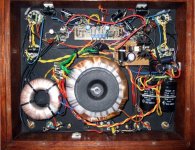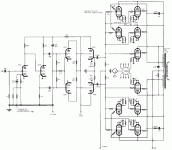Salas,
DC coupled IRFBC20 source followers between the splitter and "finals" buy you immunity against Miller capacitance and also keep the splitter stage gain up. The modest value grid leak resistors needed in combination with the individually adjustable bias set pots. indicated for PPP are not a problem.
A Mullard style circuit using a 6GK5 voltage amplifier and 12AT7 LTP splitter offers plenty of open loop gain. High gm small signal tubes provide resistance against slew limiting.
Is an octet of "reissue" GEC KT88s part of your plan? It's too bad that you can't source decent EI KT90s, which KILL in triode mode.
DC coupled IRFBC20 source followers between the splitter and "finals" buy you immunity against Miller capacitance and also keep the splitter stage gain up. The modest value grid leak resistors needed in combination with the individually adjustable bias set pots. indicated for PPP are not a problem.
A Mullard style circuit using a 6GK5 voltage amplifier and 12AT7 LTP splitter offers plenty of open loop gain. High gm small signal tubes provide resistance against slew limiting.
Is an octet of "reissue" GEC KT88s part of your plan? It's too bad that you can't source decent EI KT90s, which KILL in triode mode.
You know I do have developed a parallel 12AY7 - 12AT7 ccs tail split - KT88 triode amp, with Audionote class B OPT that I underestimated initially as just a good PP amp, but after bringing high rated stuff around it holds its own very well over time and challenge, so I thought of being able to build more power on it wasn't a bad idea. Yes Genalex KT88 is the best current power tube I know of. And I would use those. I thought of the mosfet buffer too, but a ccs and a mosfet buffer is ''powerdrive'' and Tube Lab will litigate!
Anyway, I have 10 NOS 5687 GE and isn't it a good alternative to a mosfet buffer? What kind of a grid leak would you use per KT88 in PPP?
As for KT90 I have used Harmonix and good vintage EI in triode mode on that amp and they are not that great. More romantic, beguiling, but KT88 is surely more real.

Anyway, I have 10 NOS 5687 GE and isn't it a good alternative to a mosfet buffer? What kind of a grid leak would you use per KT88 in PPP?
As for KT90 I have used Harmonix and good vintage EI in triode mode on that amp and they are not that great. More romantic, beguiling, but KT88 is surely more real.
Attachments
I thought of the mosfet buffer too, but a ccs and a mosfet buffer is ''powerdrive'' and Tube Lab will litigate!
Power drive DC couples the FET to the "final". I suggest you DC couple the FET to the splitter. The requisite individual bias adjustments for PPP make (IMO) a single FET and individual coupling caps. more attractive than a single coupling cap. and multiple FETs.
As for KT90 I have used Harmonix and good vintage EI in triode mode on that amp and they are not that great. More romantic, beguiling, but KT88 is surely more real.
The EH KT90 is not a good sounding tube. I suspect that which O/P trafo is used affects whether properly made EI KT90s or "reissue" GEC KT88s sound best. The EI tube is golden in combination with the Freed trafos used on H/K Cit. 2s.
What kind of a grid leak would you use per KT88 in PPP?
Follow the recommendation on the GEC data sheet of not more than 100 KOhms total, when "fixed" bias is employed.
...a ccs and a mosfet buffer is ''powerdrive'' and Tube Lab will litigate
I don't understand. Is powerdrive patented?
SpreadSpectrum said:I don't understand. Is powerdrive patented?
I don't see how. People were building such things long before tubelab showed up here.
leadbelly said:
I don't see how. People were building such things long before tubelab showed up here.
Joke, joking, humor. I just remembered our good member Tubelab and Powerdrive the way the circuit was going. Hence the hammer emoticon.
I don't claim to be the "inventor" of PowerDrive, I just gave the circuit a name. I posted it on my web site for all to use, modify and generally do whatever with. I can say that I had not seen the circuit or the CCS - mosfet combination before I "discovered" it. That doesn't mean that it didn't exist. I have used a single triode with a CCS load feeding multiple mosfets to drive multiple tubes. It works good and allows for individual bias adjustments. I can say that I have not tried 10 KT88's at the same time yet!
Eli Duttman said:
*
Power drive DC couples the FET to the "final". I suggest you DC couple the FET to the splitter. The requisite individual bias adjustments for PPP make (IMO) a single FET and individual coupling caps. more attractive than a single coupling cap. and multiple FETs.
**
The EH KT90 is not a good sounding tube. I suspect that which O/P trafo is used affects whether properly made EI KT90s or "reissue" GEC KT88s sound best. The EI tube is golden in combination with the Freed trafos used on H/K Cit. 2s.
***
Follow the recommendation on the GEC data sheet of not more than 100 KOhms total, when "fixed" bias is employed.
Thanks Eli
*Still a heavily biased 5687 buffer leaves you cold vs the FET?
** Yes the EH KT90 sounds forward and soft. The EI KT90 did not sound on par with Genalex reissue KT88 on the Ultralinear Jadis DA30 that has OPTs specifically made for EI KT90. The EI si consistently darker, less informative, and slower on the Jadis and on my triode amp vs the Gen KT88. With other trafos it may be superior in triode mode, since you have experienced it.
***
No problem for buffers to drive 100k and maybe 60pf per phase then.
tubelab.com said:I don't claim to be the "inventor" of PowerDrive, I just gave the circuit a name. I posted it on my web site for all to use, modify and generally do whatever with. I can say that I had not seen the circuit or the CCS - mosfet combination before I "discovered" it. That doesn't mean that it didn't exist. I have used a single triode with a CCS load feeding multiple mosfets to drive multiple tubes. It works good and allows for individual bias adjustments. I can say that I have not tried 10 KT88's at the same time yet!
Hello! In my view you did well to give a name, it increases awareness. Is life back on better track by now? Shipping kits?
Is IRF840 a good sounding one?
The IRF840 has a lot of capacitance. The important spec for a follower is the "reverse transfer capacitance". It should be low and constant above a certain voltage. The IRF840 is 80 pF. My favorite is now the Toshiba 2SK3563. It is 7 pF. The Fairchild FQP1N50 is 4 pF, another good choice, but at least here the Toshiba is cheaper and has an insulated case.
otto88 said:Eli
“too bad that you can't source decent EI KT90s, which KILL in triode mode”
EI isn’t Electro Harmonix. . what is it short for?
And (I’m considering a switchable triode/ Ultralinear amp): do KT90s, like KT88s (but not 6550s), work well in UL mode?
Thanks
EI is short for Elektronska Inustrija, a company from Yugoslavia, now Serbia. Very often you will see it as EI Nis, which is city where it is from.
Please correct me if I am wrong: Is KT90 newer tube? I think it is EI who came up with that tube not that long ago (or was it a reissue) here I am not sure so feel free to correct.
AR2 said:
Please correct me if I am wrong: Is KT90 newer tube? I think it is EI who came up with that tube not that long ago (or was it a reissue) here I am not sure so feel free to correct.
New grain + old chaff.. origins of KT90 for audio, I believe derived from Manley Labs around mid 90's...modifying TV lineout tubes. power good but quality appalling.
Other members may have more info.
richj
otto88 said:Thanks AR2.
Is EI still in production?
I do not know for sure. I know that they have changed the ownership and that people that used to do it started it on their own or they were planning to start it on their own. A few years ago I got the email address for the main engineer, who was the one responsible for the design of KT90. I am not sure that I could easily find it out again, but if there is a big interest I will be able to poke it out and post the question. I am really not that well informed on availability of these tubes and the production whereabouts but like I explained I could find out more if there is a big interest.
Please let me know and I will look for some more info.
- Status
- This old topic is closed. If you want to reopen this topic, contact a moderator using the "Report Post" button.
- Home
- Amplifiers
- Tubes / Valves
- 4XKT88 drive

